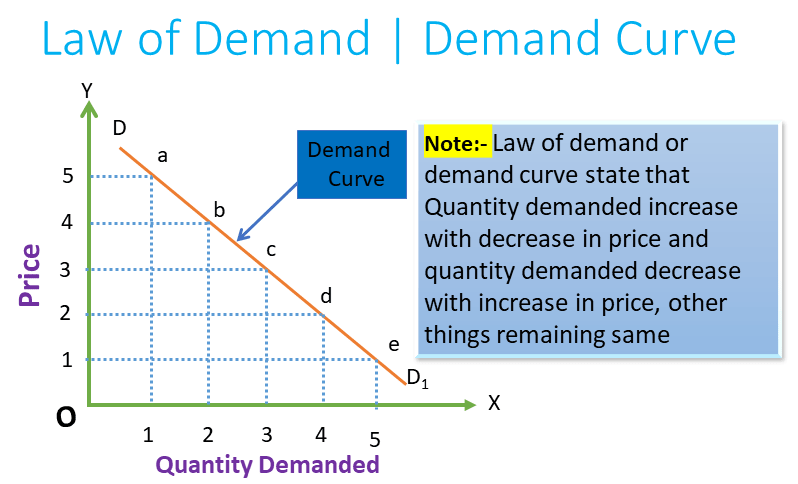Concept of Demand
Demand refers to the wiliness and ability of consumers to purchase goods and services from the market at various prices per period of time, other things remain constant. For effective demand, Consumers have both the desire (wiliness) and the ability to pay for it. If consumers have desires for goods and services but, do not have the ability to pay for them. Then, it is not considered an effective demand. Let`s discuss it through the following example
Example of Demand
Let`s discuss Demand through the example; if a “Beggar” is willing to have an iPhone. But, not has the ability to pay for it. Then, this considered as his/her desire not the demand of the market. Some of the elements are required for effective demand which is discussed below
Basic elements required for demand;
i) Desire of goods and services
The first necessary condition required to be demand is that consumers should have the desire to purchase available goods and services from the market.
ii) Ability to Pay
Ability to pay refers to the purchasing power of the individual. If the consumer has the desire for luxury goods. But, don’t have the capacity to pay for it. Then, it is not considered as demand. Desire must be backed up by the purchasing power(Ability to pay)
iii) Willingness to pay
The individual also has the readiness to pay for goods and services at various market prices.
iv) Per Period of time
The quantity demanded for goods and services must be time-related. Suppose, a consumer wants to purchase a sweater in the summer season or woolen clothes in the summer season. Then this is not considered as the quantity demanded of the market. This time period may be hours, days, months,s, etc.
v) Other things remaining same
There are various factors other than price that affect the quantity demanded of a product in the market. Such factors are like; income of the consumer, tastes, and preference of the consumers, size of the population, etc.
vi) Availability of goods and services in the market
The goods and services that consumers want to purchase and ready to pay for is for it should available in the market.
Demand Function
A function shows the relationship between two or more than two dependent and independent variables. These variable refers to the factor that affects the market demand such as taste and preference of the consumer, income of the consumer, size of the population, price of complementary and substitute goods, etc. But, we consider only two factors while describing the demand function i.e. price of the goods (independent variable) and quantity demanded (dependent variable). We mainly considered these two factors while describing the demand function because the price is the primary factor that mostly affects the demand for goods. Mathematically, it is expressed as;
But, if the demand is changed due to other determents than the price of the goods. Then, the relationship between the demand of the commodity and their relative determinants can mathematically be expressed as;
Determinants of Demand
Demand for goods and services differ from place to place, from time to time, person to person. There are certain factors that are responsible for fluctuating demand. These are known as determinants of demand. Some of them are listed below:
i) Price of the product
The price of the commodity is the main determinant of change in demand. Quantity demanded increase for a particular product when the price of that product decrease and vice-versa. It means, there is negative relationship between price and quantity demanded.
ii) Income of the consumer
The income of the consumer also affects the quantity demanded of a commodity. When the income of the consumer increase then consumer purchase more quantity of commodity and when consumer income decrease, they demanded less quantity of a commodity. It means, there is a positive relationship between the income of the consumer and the quantity demanded.
iii) Price of related goods (Substitute and Complementary goods)
Price of related goods (Substitute and Complementary goods) also affect the demand for the commodity. In the condition of substitute goods(Tea and Coffee), if price of tea increase then quantity demanded for Coffee increased and vice-versa. In the case of Complementary good ( Pen and Ink), if price of increase then quantity demanded for pen decrease ad vice-versa.
iv) Size of Population
The size of the population also affects the quantity demanded of a product. If the size of the population is higher then consumer demand more units of product and if the size of the population is lower then the demand that quantity is less.
v) Taste and preferences of the consumer
If the taste and preferences of goods are accordance to the consumer then demand of that goods increase and vice-versa. In other words, we also says that if consumer prefers a good, then demand for that good will be high and vice-versa.
Vi) Fear of being shortage
If the consumer have fear of shortage of goods in coming future then demand of the goods increase in the present time.
vii) Custom and tradition
Custom and tradition also affect the demand for goods. For example; the goods related to the annual festivals like Deepawali, Chhath are increasing in the time of Deepawali, chhath, etc.
Law of Demand
Alfred Marshall developed the law of demand to describe the relationship between the price and quantity demand of particular goods and services. Law of demand states that when price increases then quantity demanded of that commodity decrease and vice-versa, other things remaining the same. In brief; an individual or consumer wants to purchase more quantity of goods and services at a lower price and less quantity of goods and services at a higher price. It means the law of demand shows an inverse or negative relationship between price and quantity demanded of a commodity, other things remaining things.
According to Alfred Marshall,
“Other things remaining the same, when the price of a commodity falls, quantity demanded for that commodity will increase and if price of that commodity rises, quantity demanded for it will decrease.”
Here, the term ‘Other things remaining same’ refers to the assumption of law of demand. Following are the assumption for studying law of demand.
- No change in the income of the consumer
- There is no change in the price of substitute and complementary goods
- No change in the taste and preference of the consumer
- No change in the size of consumer
- There is no change in the advertisement
Let’s discuss Law of Demand with the below tables;
| Combinations | Price of good -X (in Rs.) | Quantity Demanded-X (units) |
|---|---|---|
| a | 5 | 1 |
| b | 4 | 2 |
| c | 3 | 3 |
| d | 2 | 4 |
| e | 1 | 5 |
Above demand, Schedule shows that consumer demanded 1 unit of quantity-X at the price of Rs. 5. When the price decline from 5 to 4, 3, 2, 1 then Consumer demand is increasing from 1 to 2, 3, 4, 5. This table shows us that when the price falls then consumer demand increased and vice-versa. This is known as the law of demand.
Let`s plot the above table in the graph to get a deep knowledge of it.

The above graph shows, DD1 curve which is downward sloping. It is known as the demand curve. From above we can see that when the price is Rs. 5, consumers want to purchase 1 unit ie. combination “a”. When price decline then consumers want to purchase more quantity ie. combination b, c, d, e. Here, decreasing in price, increase the demand for goods and vice-versa. Due to this, the demand curve is always downward sloping.
Exceptions of the Law of Demand
There are certain factors that violate this law (Law of Demand). It is called exceptions or limitations of the law of demand. Some of them are described below;
i) Change in income of the consumer
The demand for goods is also affected by the income of the consumer. If there is increase in income of the consumer, then quantity demanded increased even at higher price. And if there is decrease in income of the consumer, then quantity demanded decrease even at lower price. It means than law of demand is not follow in the market if consumer income is changed.
ii) Necessary goods
Necessary goods are those goods that are required in day-to-day life. Such goods are Salt, medicine, matchbox, etc. The demand for these goods remaining unchanged for any level of price. Law of demand is not follow in the case of necessary goods.
iii) Change in size of Population
When the size of the population increase, the demand for the commodity also increases even at a higher price. Likewise, if the size of the population decrease then demands for the commodity also decrease even at a higher price. The law of demand is not applied when the size of the population is changing.
iv) Giffen goods
The Law of demand does not apply in the case of Giffen goods because the demand for Giffen goods is in direct proportion to the price of goods. It means when the price of Giffen goods increases then quantity demanded also increases and vice-versa. There is a positive relationship between price and quantity demanded of Giffen goods.
v) Change in price of related goods
Law of demand is also not follows when price of related goods (i.e. complementary and substitutes goods) changed. In substitute goods like tea and coffee, when price of tea increase then demand for coffee increase even at constant price and vice-versa. In Complementary goods like Ink and Pen, When price of ink increase then demand of pen decreased even at constant price and vice-versa.
vi) Price or shortage expectation
If the consumer has fear of shortage of particular goods or increases in the price of goods in coming future, then quantity demanded of that goods increase in present time.
vii) Cultural and religious factor
This law doesn’t apply in the case of goods that are related to culture and religion. For example; the demand for goods used on festivals (chhath, Dashain, Deepawali) like sugar, sweets, banana, etc demand increased in the time of festivals even at higher prices.
| Reference Book |
|---|
| Asmita Publication |
| Buddha Academic Enterprises Pvt. Ltd |



